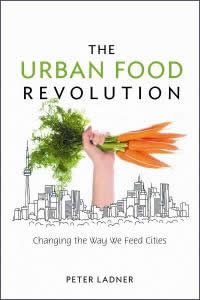 Peter Ladner writes The Urban Food Revolution from the perspective of a policy maker–he was a two-term City Councillor in Vancouver, B.C.–and a journalist. This is not a gardening book or even an urban farming book, but it does examine issues that impact food production and distribution in an urban setting with the goal of telling policymakers “…what they can do to improve access to healthy food for all the people they represent.” Subjects addressed include food deserts, childhood obesity, designing new developments with urban farming options, and the safety of locally raised food.
Peter Ladner writes The Urban Food Revolution from the perspective of a policy maker–he was a two-term City Councillor in Vancouver, B.C.–and a journalist. This is not a gardening book or even an urban farming book, but it does examine issues that impact food production and distribution in an urban setting with the goal of telling policymakers “…what they can do to improve access to healthy food for all the people they represent.” Subjects addressed include food deserts, childhood obesity, designing new developments with urban farming options, and the safety of locally raised food.
Excerpted from the Winter 2013 Arboretum Bulletin.
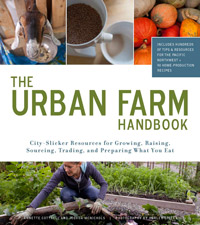 The Urban Farm Handbook is a blending of deeply personal accounts by two urban (Seattle) families seeking ways of becoming self-reliant in producing and preparing food. By sharing both the triumphs and failures (including persuading significant others), Annette Cottrell and Joshua McNichols present a lot of options for choosing your own path to provide food for yourself and loved ones. Recipes are scattered throughout, and many of those contain meat. Dealing with the angst of slaughtering various animals to supply that meat is a significant theme of the book, but here, too, the authors give you many options for finding your own comfort level.
The Urban Farm Handbook is a blending of deeply personal accounts by two urban (Seattle) families seeking ways of becoming self-reliant in producing and preparing food. By sharing both the triumphs and failures (including persuading significant others), Annette Cottrell and Joshua McNichols present a lot of options for choosing your own path to provide food for yourself and loved ones. Recipes are scattered throughout, and many of those contain meat. Dealing with the angst of slaughtering various animals to supply that meat is a significant theme of the book, but here, too, the authors give you many options for finding your own comfort level.
Excerpted from the Winter 2013 Arboretum Bulletin.
 Robert and Hannah Litt own the Urban Farm Store in Portland and wrote “A Chicken in Every Yard” from experience keeping their own chickens, and helping their chicken-keeping customers. While they don’t disapprove of raising chickens for food, theirs are clearly pets and the book encourages this attitude with chapters like “Parenting Your Peeps.” There is a lot of detail about different types and breeds, including recommendation lists such as “best for children.” All stages of raising and caring are covered in depth, but the garden is only briefly mentioned. If your focus is solely on chickens, this book is an excellent choice.
Robert and Hannah Litt own the Urban Farm Store in Portland and wrote “A Chicken in Every Yard” from experience keeping their own chickens, and helping their chicken-keeping customers. While they don’t disapprove of raising chickens for food, theirs are clearly pets and the book encourages this attitude with chapters like “Parenting Your Peeps.” There is a lot of detail about different types and breeds, including recommendation lists such as “best for children.” All stages of raising and caring are covered in depth, but the garden is only briefly mentioned. If your focus is solely on chickens, this book is an excellent choice.
Excerpted from the Winter 2013 Arboretum Bulletin.

First review:
Jessi Bloom is a strong advocate for chickens in almost any garden setting, and in “Free-Range Chicken Gardens,” she provides detailed information on compatible plantings–including those that provide food for chickens–and structures that meet the multiple needs of fowl and flora. There is a lot of well-organized information in these pages on all other related topics, too, making this of value to chicken keepers at any experience level. But you can also just enjoy the profiles of gardeners and their chickens (many are local) or the many superb photographs (by Kate Baldwin) of contented hens in their gardens, proving their value as a natural compliment.
Excerpted from the Winter 2013 Arboretum Bulletin.
Second review:
How does allowing chickens to range freely work with a garden? Very well – it just takes a lot of compromise and ingenuity. A book that deeply addresses these issues is Free-Range Chicken Gardens by Jessi Bloom of Seattle.
Here are specific guidelines for the design of a chicken compatible landscape. How to protect prize plants while still giving your flock the opportunity to roam and find a more natural diet. As a gardener, you are encouraged to try plant selections that will nourish your hens, or shelter them from predators or weather. The advantages can work both ways. Some plants will screen your chicken run, or even give off fragrance to mask odors.
Bloom recognizes this doesn’t work for everyone. “If your garden must be perfect…then you might not want chickens free ranging.”
Published in Garden Notes: Northwest Horticultural Society, Fall 2018
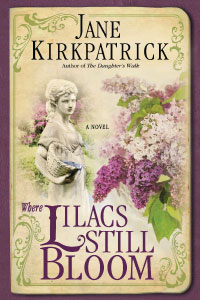 Hulda Klager (1863-1960) was a Pacific Northwest pioneer. This Woodland, Washington farm wife survived numerous hardships, but is best remembered for the wonderful collection of lilacs she hybridized and introduced in the first half of the 20th century, and the garden now open to the public that displays those lilacs. The historical novel “Where Lilacs Still Bloom” by Jane Kirkpatrick is largely an accurate biography, with only minor liberties taken to amalgamate some of the real life personalities in Klager’s life.
Hulda Klager (1863-1960) was a Pacific Northwest pioneer. This Woodland, Washington farm wife survived numerous hardships, but is best remembered for the wonderful collection of lilacs she hybridized and introduced in the first half of the 20th century, and the garden now open to the public that displays those lilacs. The historical novel “Where Lilacs Still Bloom” by Jane Kirkpatrick is largely an accurate biography, with only minor liberties taken to amalgamate some of the real life personalities in Klager’s life.
Excerpted from the Fall 2012 Arboretum Bulletin.
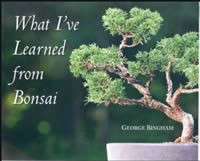 George Bingham is based in Olympia and had been engaged in bonsai for about nine years when “What I’ve Learned from Bonsai” was published in 2008. This very personal book shares his observation about both the art of bonsai and the life lessons he has gained while working with his plants and living with multiple sclerosis.
George Bingham is based in Olympia and had been engaged in bonsai for about nine years when “What I’ve Learned from Bonsai” was published in 2008. This very personal book shares his observation about both the art of bonsai and the life lessons he has gained while working with his plants and living with multiple sclerosis.
Excerpted from the Fall 2012 Arboretum Bulletin.
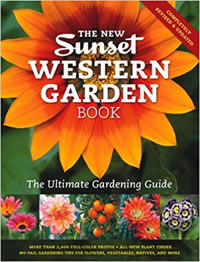 The grandparent of all gardening books for the Pacific Northwest and rest of the west remains the “Sunset Western Garden Book.” Now in its new, ninth edition, the proven encyclopedic formula, along with essays, extensive plant selection lists for specific needs, and the much valued Sunset climate zones (all updated) continue to make this a must on any western gardener’s shelf. The main addition since the last edition of 2007 is photographs in the encyclopedia–a nice update!
The grandparent of all gardening books for the Pacific Northwest and rest of the west remains the “Sunset Western Garden Book.” Now in its new, ninth edition, the proven encyclopedic formula, along with essays, extensive plant selection lists for specific needs, and the much valued Sunset climate zones (all updated) continue to make this a must on any western gardener’s shelf. The main addition since the last edition of 2007 is photographs in the encyclopedia–a nice update!
Excerpted from the Fall 2012 Arboretum Bulletin.
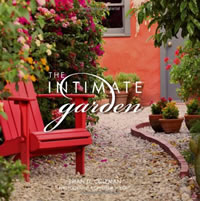 Consider “The Intimate Garden” for very detailed examples of highly individualized garden spaces, with an emphasis on hardscape and ornaments. While both author Brian Coleman and photographer William Wright are from Seattle and the gardens are mostly on the west coast, examples from the east coast and even England are included, making this a very diverse selection of design styles and plant material.
Consider “The Intimate Garden” for very detailed examples of highly individualized garden spaces, with an emphasis on hardscape and ornaments. While both author Brian Coleman and photographer William Wright are from Seattle and the gardens are mostly on the west coast, examples from the east coast and even England are included, making this a very diverse selection of design styles and plant material.
Excerpted from the Fall 2012 Arboretum Bulletin.
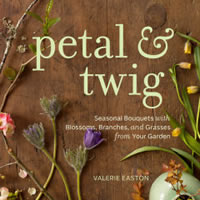 Valerie Easton’s “Petal & Twig”, tells how to find a source of material for flower arranging in your own garden. If–like me–you’ve ever struggled with getting your home arrangements just right, Easton will loosen you up and give you permission to just go for it, and open your eyes to more possibilities than you ever imagined a few feet from your back door. “After all, you’re crafting performance art that changes hour by hour, day by day, as buds open, petals drop, and flowers droop. Imperfection engages us in the creative process.”
Valerie Easton’s “Petal & Twig”, tells how to find a source of material for flower arranging in your own garden. If–like me–you’ve ever struggled with getting your home arrangements just right, Easton will loosen you up and give you permission to just go for it, and open your eyes to more possibilities than you ever imagined a few feet from your back door. “After all, you’re crafting performance art that changes hour by hour, day by day, as buds open, petals drop, and flowers droop. Imperfection engages us in the creative process.”
Excerpted from the Fall 2012 Arboretum Bulletin.
 “When Debra and David began interviewing and photographing people who grow and arrange fresh, seasonal flowers for local markets, I knew they were documenting a new movement…you could call it the slow flower movement.” This quote, by Amy Stewart from the Foreword of “The 50 Mile Bouquet,” well summarizes this forward-looking book by Debra Prinzing and David Perry, which leaves you with a wider perspective and appreciation of fresh cut flowers and other greenery. This is in sharp contrast to the international florist industry, making Stewart’s 2007 book about that industry, “Flower Confidential,” a good companion reading (Stewart–who lives in Eureka, California–almost qualifies as a local author).
“When Debra and David began interviewing and photographing people who grow and arrange fresh, seasonal flowers for local markets, I knew they were documenting a new movement…you could call it the slow flower movement.” This quote, by Amy Stewart from the Foreword of “The 50 Mile Bouquet,” well summarizes this forward-looking book by Debra Prinzing and David Perry, which leaves you with a wider perspective and appreciation of fresh cut flowers and other greenery. This is in sharp contrast to the international florist industry, making Stewart’s 2007 book about that industry, “Flower Confidential,” a good companion reading (Stewart–who lives in Eureka, California–almost qualifies as a local author).
Excerpted from the Fall 2012 Arboretum Bulletin.
 Peter Ladner writes The Urban Food Revolution from the perspective of a policy maker–he was a two-term City Councillor in Vancouver, B.C.–and a journalist. This is not a gardening book or even an urban farming book, but it does examine issues that impact food production and distribution in an urban setting with the goal of telling policymakers “…what they can do to improve access to healthy food for all the people they represent.” Subjects addressed include food deserts, childhood obesity, designing new developments with urban farming options, and the safety of locally raised food.
Peter Ladner writes The Urban Food Revolution from the perspective of a policy maker–he was a two-term City Councillor in Vancouver, B.C.–and a journalist. This is not a gardening book or even an urban farming book, but it does examine issues that impact food production and distribution in an urban setting with the goal of telling policymakers “…what they can do to improve access to healthy food for all the people they represent.” Subjects addressed include food deserts, childhood obesity, designing new developments with urban farming options, and the safety of locally raised food.
 Robert and Hannah Litt own the Urban Farm Store in Portland and wrote
Robert and Hannah Litt own the Urban Farm Store in Portland and wrote 
 Hulda Klager (1863-1960) was a Pacific Northwest pioneer. This Woodland, Washington farm wife survived numerous hardships, but is best remembered for the wonderful collection of lilacs she hybridized and introduced in the first half of the 20th century, and the garden now open to the public that displays those lilacs. The historical novel “Where Lilacs Still Bloom” by Jane Kirkpatrick is largely an accurate biography, with only minor liberties taken to amalgamate some of the real life personalities in Klager’s life.
Hulda Klager (1863-1960) was a Pacific Northwest pioneer. This Woodland, Washington farm wife survived numerous hardships, but is best remembered for the wonderful collection of lilacs she hybridized and introduced in the first half of the 20th century, and the garden now open to the public that displays those lilacs. The historical novel “Where Lilacs Still Bloom” by Jane Kirkpatrick is largely an accurate biography, with only minor liberties taken to amalgamate some of the real life personalities in Klager’s life. George Bingham is based in Olympia and had been engaged in bonsai for about nine years when “What I’ve Learned from Bonsai” was published in 2008. This very personal book shares his observation about both the art of bonsai and the life lessons he has gained while working with his plants and living with multiple sclerosis.
George Bingham is based in Olympia and had been engaged in bonsai for about nine years when “What I’ve Learned from Bonsai” was published in 2008. This very personal book shares his observation about both the art of bonsai and the life lessons he has gained while working with his plants and living with multiple sclerosis. The grandparent of all gardening books for the Pacific Northwest and rest of the west remains the “Sunset Western Garden Book.” Now in its new, ninth edition, the proven encyclopedic formula, along with essays, extensive plant selection lists for specific needs, and the much valued Sunset climate zones (all updated) continue to make this a must on any western gardener’s shelf. The main addition since the last edition of 2007 is photographs in the encyclopedia–a nice update!
The grandparent of all gardening books for the Pacific Northwest and rest of the west remains the “Sunset Western Garden Book.” Now in its new, ninth edition, the proven encyclopedic formula, along with essays, extensive plant selection lists for specific needs, and the much valued Sunset climate zones (all updated) continue to make this a must on any western gardener’s shelf. The main addition since the last edition of 2007 is photographs in the encyclopedia–a nice update! Consider “The Intimate Garden” for very detailed examples of highly individualized garden spaces, with an emphasis on hardscape and ornaments. While both author Brian Coleman and photographer William Wright are from Seattle and the gardens are mostly on the west coast, examples from the east coast and even England are included, making this a very diverse selection of design styles and plant material.
Consider “The Intimate Garden” for very detailed examples of highly individualized garden spaces, with an emphasis on hardscape and ornaments. While both author Brian Coleman and photographer William Wright are from Seattle and the gardens are mostly on the west coast, examples from the east coast and even England are included, making this a very diverse selection of design styles and plant material. Valerie Easton’s “Petal & Twig”, tells how to find a source of material for flower arranging in your own garden. If–like me–you’ve ever struggled with getting your home arrangements just right, Easton will loosen you up and give you permission to just go for it, and open your eyes to more possibilities than you ever imagined a few feet from your back door. “After all, you’re crafting performance art that changes hour by hour, day by day, as buds open, petals drop, and flowers droop. Imperfection engages us in the creative process.”
Valerie Easton’s “Petal & Twig”, tells how to find a source of material for flower arranging in your own garden. If–like me–you’ve ever struggled with getting your home arrangements just right, Easton will loosen you up and give you permission to just go for it, and open your eyes to more possibilities than you ever imagined a few feet from your back door. “After all, you’re crafting performance art that changes hour by hour, day by day, as buds open, petals drop, and flowers droop. Imperfection engages us in the creative process.” “When Debra and David began interviewing and photographing people who grow and arrange fresh, seasonal flowers for local markets, I knew they were documenting a new movement…you could call it the slow flower movement.” This quote, by Amy Stewart from the Foreword of “The 50 Mile Bouquet,” well summarizes this forward-looking book by Debra Prinzing and David Perry, which leaves you with a wider perspective and appreciation of fresh cut flowers and other greenery. This is in sharp contrast to the international florist industry, making Stewart’s 2007 book about that industry, “Flower Confidential,” a good companion reading (Stewart–who lives in Eureka, California–almost qualifies as a local author).
“When Debra and David began interviewing and photographing people who grow and arrange fresh, seasonal flowers for local markets, I knew they were documenting a new movement…you could call it the slow flower movement.” This quote, by Amy Stewart from the Foreword of “The 50 Mile Bouquet,” well summarizes this forward-looking book by Debra Prinzing and David Perry, which leaves you with a wider perspective and appreciation of fresh cut flowers and other greenery. This is in sharp contrast to the international florist industry, making Stewart’s 2007 book about that industry, “Flower Confidential,” a good companion reading (Stewart–who lives in Eureka, California–almost qualifies as a local author).